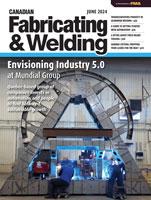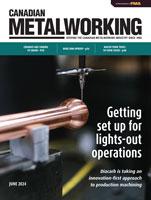- FMA
- The Fabricator
- FABTECH
- Canadian Metalworking
New software, machine tool enables multiaxis production
Big Drum uses multiaxis toolpaths to serve its medical industry customers
- June 26, 2024
- Article
- Automation and Software

Brody Huk uses Stock Model to create a 3D, manoeuvrable virtual representation of the part for each stage of milling. As he progresses, he only needs to apply new toolpaths to the remaining stock, reducing time wasted at the machine. Images: Big Drum Precision Machining and Automation
Situation
Big Drum Precision Machining and Automation, Burlington, Ont., looks a lot different now than it did when it first opened its doors in 1997.
The manufacturer began by creating assemblies for packaging ice cream for the dairy industry. Soon, however, it started machining its own parts and even started taking on small production runs for other local businesses.
When the original owners eventually sold Big Drum and retired, they did so with the assurance that the company would continue to grow. And grow it has.
Big Drum is now capable enough to take on practically any custom work that can be drawn up. Parts are machined from a customer-provided print, or its engineering team assists with product development, especially for creating more affordable, more effective parts. It handles the design for manufacturing, machining, assembly, and kitting.
Big Drum’s expertise in these areas has even attracted attention from the medical automation industry. One of its biggest customers is a medical device manufacturer that specializes in automated cells.
Like the manufacturing sector, the medical industry is rapidly adopting automation practices to streamline processes. These automated cells work inside medical testing laboratories for operations like pipetting, loading and running centrifuges, and labelling samples.
When Brody Huk, manufacturing engineer, was first hired by Big Drum, he was already familiar with its Mastercam CAD/CAM operating system from CNC Software, Tolland, Conn. He had taught himself how to use it during his time off from school. Not only did he know the system well enough to use it at Big Drum to make the company’s high-precision parts, Huk also knew enough to see that the software was not being used to its full potential. He challenged his boss to upgrade the software and to let him show everyone what it could really do in high-tolerance work. When he did, Huk changed how Big Drum operated. But that wasn’t the only change.
Resolution
Because its software was now more capable, the company invested more into its machining capacity. One such investment occurred in April 2023, when Big Drum installed a Matsuura MX-330 PC10 vertical multiaxis machining centre with 10 pallets and 90-tool capacity. The addition transformed the shop from one focused mainly on 2D milling and basic lathe work to one fully capable of taking on any 3D multiaxis application. According to the company, the machine has already markedly reduced labour, hand work, and setups; it also promises to widen margins with each quarter.
Parts that were previously machined using traditional 3-axis strategies now have multiaxis techniques applied to them.
“The way the software works, it’s easy to port my programs over from 3-axis and only tweak a couple things,” said Huk.

To remove the exact amount of material required, Big Drum uses Dynamic Mill toolpaths and stock-aware machining approaches designed to intelligently remove material.
The coding works quickly and simply, meaning he has more time to focus on more complex parts, like the robotic components of the company’s automation cells.
Big Drum recently produced a run of robotic arm grippers on its new multiaxis machining centre for a customer in the medical laboratory automation industry. The customer produces automated cells that move medical samples through various testing machines. The arm and gripper are particularly tricky to manufacture because 85 per cent of the original 6061 aluminum must be machined away without sacrificing the arm’s stability. The part could not be machined without multiaxis technology because it could not have been supported well enough during machining to make both profitability and part integrity possible.
A wing on the gripper is somewhat suspended in space by a very thin gusset. Take too much off around the gusset, and the part crumples. Take too little off, and the part loses its mobility and much of its function. To safely remove the right amount, Huk uses his Dynamic Mill toolpaths. Dynamic Motion technology, the parent group of tools to Dynamic Mill, consists of numerous stock-aware machining approaches designed to intelligently remove material. Dynamic toolpaths calculate the best angle, speed, and depth to engage the cutting tool, and also make instant adjustments to these calculations during machining.
During milling, this translates to fast, reliable material removal. The Dynamic Mill approach mills away that section of the block while it is supported and then returns to drill the precision holes. Then Huk creates a stock model within the toolpaths group.
The Stock Model feature creates a 3D, manoeuvrable virtual representation of the part for each stage of milling. As users progress, they need only apply new toolpaths to the remaining stock, drastically reducing wasted motion at the machine. Huk uses the succession of updated models to follow the machining process and to find the best approaches for removing the next batch of material.
“I drive the rest of my machining off that stock model to avoid air cuts,” he said. “The software keeps track of exactly where all the material is during each phase of machining.”
The stock model keeps operations tied to a 3D model, and it makes it easy for Huk to apply consecutive Dynamic toolpaths in various reorientations and view planes. According to Huk, he prefers to use Dynamic toolpaths because of their good cut pattern, increased tool life, and repeatability.
Huk likes to watch onscreen as the gripper is manipulated in five axes. With Mastercam simulation, he can play each stage of the machining process in real time. As the simulation plays, it automatically screens for excess flex in material, subpar surface finishes, and loss of rigidity. Once the issues are flagged, a few keystrokes are enough to make the necessary adjustments and get the code back on the machine.
“It’s awesome having this machine simulation suite built into Mastercam. As I’m buying tools, I can drop them directly into my CAM software and check for collisions and avoidances,” said Huk. “It’s been extremely helpful in lessening the learning curve because as our 5-axis jobs take off, our focus is going to be on reducing hand-working parts after machining and reducing setups.
“The software makes it easy to import programs over from 3-axis and just redo a couple of areas rather than start from scratch. I can have working code very quickly,” Huk added.

Big Drum’s Matsuura MX-330 PC10 vertical multiaxis machining centre has reduced labour, hand work, and setups.
As he continues to learn the nuances of his CAD/CAM software, Huk appreciates the simulation more and more. It frees him up from becoming anxious about unexpected gouges, air cuts, and machine crashes.
With this free time, he can learn even more from the certified reseller, In-House Solutions, Cambridge, Ont. It was the In-House team that introduced him to the software’s Tool Library, for example, where he can drop virtual tools directly into his software as he purchases them. As he does, their specifications and use data is stored, waiting to be input alongside machining toolpaths.
The In-House applications experts also help Huk dial in his post-processors and are a key link to his Matsuura machine.
“If I reach out, in an hour I can expect to have a good post-processor that works crash-free and pairs with my simulator,” he said. In-House also keeps Big Drum’s software up to date and occasionally offers programmer training.
For additional training, the Big Drum team has made use of Mastercam University, an online portal filled with self-paced classes on subjects like machining principles, basic lathe, and multiaxis machining. While Huk encourages his programmers to pursue their continued education, the owners of Big Drum have made the courses available to all employees, regardless of their position.
“We’re not trying to force anyone to become a programmer. We just want everyone to have the opportunity for growth,” said Huk.
Big Drum Precision Machining and Automation, www.bigdrum.ca
Mastercam, www.mastercam.com
Related Companies
subscribe now


Keep up to date with the latest news, events, and technology for all things metal from our pair of monthly magazines written specifically for Canadian manufacturers!
Start Your Free Subscription- Trending Articles
5 benefits of non-contact systems that detect broken tools

Creating local and global excellence at Précision SFTech

Haimer USA names new COO and VP of marketing

Sciaky EBAM-made part lands on moon in IM-1 mission lander’s engine

Bobcat breaks ground for Mexico manufacturing facility

- Industry Events
IMTS 2024
- September 9 - 14, 2024
- Chicago, IL
WiM Summit 2024
- October 6 - 9, 2024
- Boston, MA
FABTECH 2024 Orlando
- October 15 - 17, 2024
- Orlando, FL















